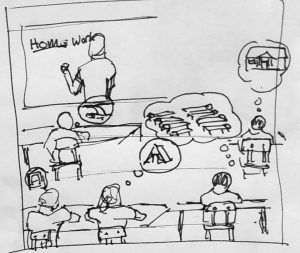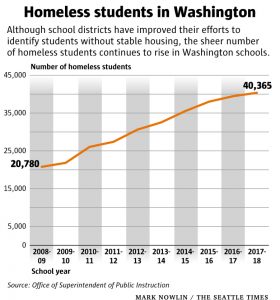Getting an accurate headcount is essential

Many people who qualify as homeless do not live on the street or solicit donations with a cardboard sign. They have full or part-time jobs, live in cars or tents, or lodge with others in dwellings designed as single family units. Among them are over 40,000 school-aged children in Washington, the equivalent of at least one unhoused child in every classroom.
Unhoused children are difficult to count. Without electricity or an internet connection, some families have given up trying to keep their kids in school. “It’s easier to send kids to a brick and mortar school and a lot harder to keep them attending when it’s online,” one spokesperson said. “We’ve been trying all summer to find these kids and get them coded as they should to be safe and secure. But that’s hard when you’re living in a car or tent,” a North Thurston School District (NTSD) representative said.
Educating unhoused children begins with identifying them. As the representative from NTSD told WIP, homeless families often don’t see themselves as homeless or needing assistance, affecting their children’s ability to receive services. “Parents may explain their living situations as temporary or intentional, like ‘we’re gypsies’ or ‘we just like living with Grandma and Grandpa.’ Children of homeless adults aren’t always visible, even to themselves.”
Challenges to gathering and interpreting data
Counties and school districts use at least two methods to track and fund unhoused children. Individual counties conduct a Point-in-Time count of homeless families every year. PIT counts also seek to identify causes of homelessness and help develop strategic planning to combat it. These reports are submitted to the legislature where they help to determine how much funding each county receives in support services for unhoused people.

Figures released by Thurston County’s PIT count suggest that homelessness among school age children in Thurston County decreased by approximately 59% from 2019 to 2021. A spokesperson from North Thurston School District said their figures indicate the number of unhoused students dropped from around 900 in 2019 to around 600 in 2020.
Both figures are misleading. Representatives for the school district say that the number of children experiencing homelessness, especially in the era of Covid, has not decreased. It’s just that many youth have disappeared from view altogether. The eviction moratorium, cited by Thurston County as a likely factor in the reduced number of homeless youth, may have given temporary respite to many families without permanent housing—but not for long.*
The other method for tracking unhoused children relies on guidelines set forth by the McKinney-Vento Homeless Education Assistance Act. The MV method also seeks to identify homeless youth to help districts get more accurate head counts; to enroll those students in school and to help them find appropriate assistance and services.
Because of privacy restrictions imposed by HUD, along with the inherent challenges of counting kids without homes, the two systems paint vastly different pictures of homeless youth in Thurston County.
In the last census, seven children showed up in person for the PIT estimate in Thurston County. In the same time period, McKinney-Vento estimated around 576 homeless students from birth to grade 12 in North Thurston public schools. Students coded under the MV system are not necessarily counted by the PIT survey. This creates a problem when school officials are trying to help legislators understand why there’s a difference in the number of students who show up in PIT counts compared to McKinney-Vento coding.
A new program to provide care and support for school enrollment
This May, a local non-profit group, TOGETHER! launched “Host Homes,” a program to house unaccompanied youth who are not in the physical care of a parent or guardian. The program, which is scheduled to begin in January, aims to match unaccompanied high school students with host families to provide youth with an option for safe, affirming home-like housing along with consistent education opportunities.
In Thurston County the host homes project will target youth 14 – 21 years of age. Program creator Kim Rinehardt says the TOGETHER! project is distinctly different from foster care. The application process and background checks required will be at least as rigorous as those for foster care, but how it will look and what it is designed to accomplish are different. For starters, after extensive matching, children choose the family they want to live with and can stay with that family as long as they like.
The program is supported by legislation that helped to overcome initial resistance to the unfamiliar model. Rinehardt created a host home coalition to educate members of both congressional houses, citing the success of other programs he helped start in school districts in Whatcom, King and Mason Counties and other rural districts in the state.
Civic organizers and school administrators in those areas vouched for the program. Rinehardt was ultimately able to convince lawmakers that TOGETHER! Host Homes would bring the same level of involvement to Thurston County.
Mobilizing the community
Gabriela Hyer, program development director for TOGETHER! Host Homes, describes the program as a community-driven effort: “We are mobilizing not only community re-sources, but our community in response to a need identified within the North Thurston and Tumwater School Districts,” she said.
Over 40 community organizations are partnering with Together! The roster of partners is long and wide: Lacey Rotary Club, North Thurston Education Foundation, City of Lacey, North Thurston School District, City of Tumwater, Tumwater HOPES, Tumwater Police Department, Tumwater School District, Community Youth Services, PiPE Olympia, Pizza Klatch, Family Education Support Services, DCYF-Thurston County, Community Services Division-Olympia CSO and Community Foundation of South Puget Sound. Olympia School District is not part of this pilot program.
Lori Lively is Managing Editor of Works in Progress.
*PIT’s website suggests the national eviction moratorium could explain the reduction in homeless students. When the extension on the moratorium expires in September, more families will probably be forced into homelessness and the number of unhoused students may rise to record levels.

Be First to Comment